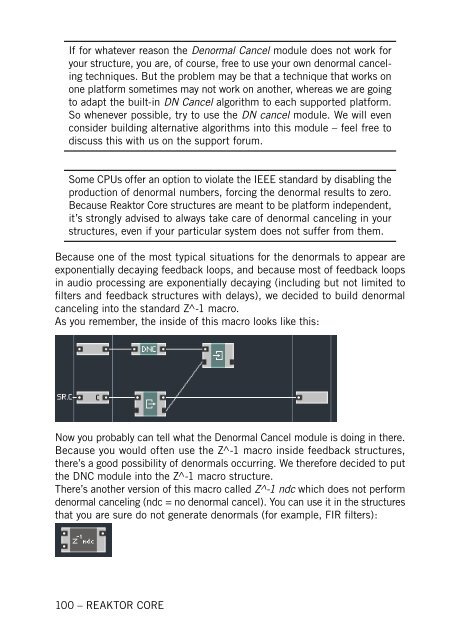1. First steps in Reaktor Core - Native Instruments
1. First steps in Reaktor Core - Native Instruments
1. First steps in Reaktor Core - Native Instruments
Create successful ePaper yourself
Turn your PDF publications into a flip-book with our unique Google optimized e-Paper software.
If for whatever reason the Denormal Cancel module does not work for<br />
your structure, you are, of course, free to use your own denormal cancel<strong>in</strong>g<br />
techniques. But the problem may be that a technique that works on<br />
one platform sometimes may not work on another, whereas we are go<strong>in</strong>g<br />
to adapt the built-<strong>in</strong> DN Cancel algorithm to each supported platform.<br />
So whenever possible, try to use the DN cancel module. We will even<br />
consider build<strong>in</strong>g alternative algorithms <strong>in</strong>to this module – feel free to<br />
discuss this with us on the support forum.<br />
Some CPUs offer an option to violate the IEEE standard by disabl<strong>in</strong>g the<br />
production of denormal numbers, forc<strong>in</strong>g the denormal results to zero.<br />
Because <strong>Reaktor</strong> <strong>Core</strong> structures are meant to be platform <strong>in</strong>dependent,<br />
it’s strongly advised to always take care of denormal cancel<strong>in</strong>g <strong>in</strong> your<br />
structures, even if your particular system does not suffer from them.<br />
Because one of the most typical situations for the denormals to appear are<br />
exponentially decay<strong>in</strong>g feedback loops, and because most of feedback loops<br />
<strong>in</strong> audio process<strong>in</strong>g are exponentially decay<strong>in</strong>g (<strong>in</strong>clud<strong>in</strong>g but not limited to<br />
filters and feedback structures with delays), we decided to build denormal<br />
cancel<strong>in</strong>g <strong>in</strong>to the standard Z^-1 macro.<br />
As you remember, the <strong>in</strong>side of this macro looks like this:<br />
Now you probably can tell what the Denormal Cancel module is do<strong>in</strong>g <strong>in</strong> there.<br />
Because you would often use the Z^-1 macro <strong>in</strong>side feedback structures,<br />
there’s a good possibility of denormals occurr<strong>in</strong>g. We therefore decided to put<br />
the DNC module <strong>in</strong>to the Z^-1 macro structure.<br />
There’s another version of this macro called Z^-1 ndc which does not perform<br />
denormal cancel<strong>in</strong>g (ndc = no denormal cancel). You can use it <strong>in</strong> the structures<br />
that you are sure do not generate denormals (for example, FIR filters):<br />
100 – REAKTOR CORE










